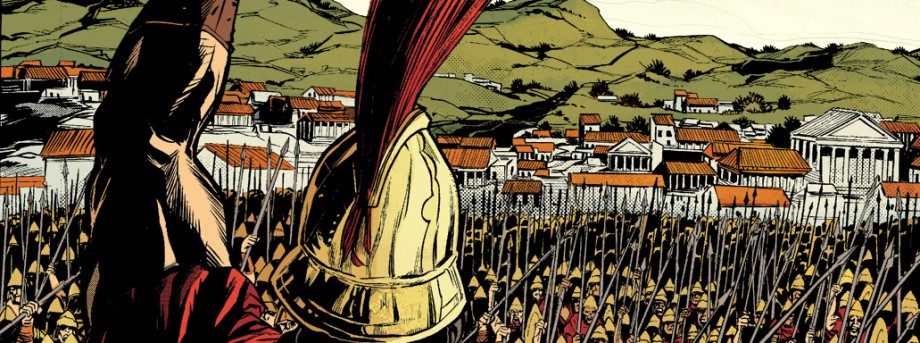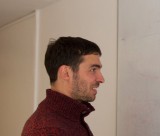The University of Nottingham
 Exchange online
Exchange online
Research Exchange
Where comics and classics collide

Academics use a variety of methods to get their work seen by a broader audience than just their students or their peers. Journal articles, conferences, teaching seminars, press releases and public lectures — all good ways of helping research have an impact on the wider world.
Professor Stephen Hodkinson of the Department of Classics chose a different route. He collaborated on a comic book.
And not just any comic book. One written by Kieron Gillen, whose other writing credits include Young Avengers, Iron Man and Journey Into Mystery for Marvel, and the critically-acclaimed, creator-owned Phonogram with artist Jamie McKelvie.
It’s an unusual collaboration, to say the least. Interpretations of Sparta are not unfamiliar in comics — Frank Miller and Lynn Varley’s 300, and the resulting film, gave the Battle of Thermopylae a whole new international audience. But one of the criticisms of 300 was its lack of historical accuracy. Something that Kieron’s response — Three — couldn’t be accused of.
Three was ‘inspired’ by 300 — a book he enjoys. Kieron describes returning home for the pub one night, picking a book randomly off the shelf and beginning to read.
“I was flicking through it and after hitting another of the lengthy monologues about these free men dying for the right of men to be freely free, I just went incandescent and pretty much snarled at the book, ‘Oh, f**k off. You people hunted slaves.’”
The story — characters, plot and denouement — came together in his mind almost instantly. Now he needed someone with extensive knowledge of Spartan life, politics and attitudes to give the book the historical authenticity so lacking in 300.
Kieron contacted Lynn Fotheringham, also of the Department of Classics, who suggested he work with Prof Hodkinson — a recognised research powerhouse on Sparta whose work has played a huge part in recent academic revisions on our view of the ancient city state.
His work in comics aside, Prof Hodkinson has worked with the Municipality of Sparti on its cultural heritage policy, influencing the way the region celebrates its history and promotes itself to visitors from across the world. His extensive research has also been cited by his peers as transforming teaching and learning on Sparta in higher education institutions worldwide.
But comics was a new path for him, and from the outset he understood that his comments on the latest understanding of Sparta might be discarded for the purposes of story.
Three tells the story of three helots — members of the Spartan slave class — and what happens to them after a violent confrontation with their masters.
“We decided that I would respect his authorial integrity and his right to make the final decision about the text in particular, but also the images. But that I would give my take on the authenticity of both the text and what I could glean about the images. I would go no holds barred in my comments, but then Kieron was free to take them up or not, or partly take them up, as he wished.”
Prof Hodkinson would see Kieron’s script along the first version of the comic’s pencils — drawn by artist Ryan Kelly. He would then send comments back to Kieron, which might lead to amends to the script and art, before the pages went to colourist Jordie Bellaire.
The very first pages of the book bear the fruits of this extensive collaboration. Kieron initially captioned one panel ‘Helots are owned by the state’. Prof Hodkinson queries this, explaining that research is moving towards the view that they were owned by individuals, but viewed collectively by the state.
The line was change to ‘The Helots also bear the state’s fetters’, which worked for Kieron from a storytelling perspective, while satisfying the need for historic authenticity.
The collaboration also informed, among many other details, when the story was set, who the characters — both Helots and Spartans — were dressed and how this reflected the story, the role of Spartan women in wider society and the landscape that the story was set in. And could it see an outlet in Kieron’s future work?
“If I ever did another Sparta book — and I’ve talked to Stephen about this — it would be completely about the women in Sparta. In terms of all the research we covered which isn’t in Three, that’s the kind of stuff that struck me as most fertile for something else.”
Kieron joined Lynn Fotheringham and Prof Hodkinson at this year’s Classical Association annual conference, hosted by The University of Nottingham. They discussed historical authenticity and storytelling, taking questions from the audience of classicists. One asked if comics could be more historically accurate than any other visual media.
“We had to portray a Sparta that would be recognisable to those who know Sparta through pop culture,” Prof Hodkinson said. “We couldn’t go away from that. At the same time, we’d done the research and Kieron used it. We navigated our way between those two imperatives.”
“If I can talk myself into sitting still for a month, I can do a comic,” Kieron added. “It’s the world’s cheapest visual storytelling medium. If you choose to be accurate, you can be accurate, and you don’t need to worry about the cost.”
Being so intimately involved in the creation of a comic has been a unique experince for Prof Hodkinson and the Department of Classics — other members of which got involved in helping shape the story when Kieron vsitited the campus on a fact-finding mission.
“The popular culture angle is important,” Prof Hodkinson said. “Several of our staff work on what’s known as classical reception — the multiple ways in which classical antiquity is used in modern culture and politics. And working on Three was a good example of classical reception in action.
“The consulting process has been a real back and forth,” Kieron said. “I was already in a position where I’d had the whole series in a draft state, so I showed him my work, he commented and so we went on.
“Some of it was purely factual, where I’d dropped the ball and misinterpreted something. Other areas were larger and more conceptual, with him bringing something from his original work which added to what I was already exploring.
“I had high hopes for the Three project. They would undoubtably have been dashed without Stephen’s assistance.”
Notes on the talk at the Classical Association have been collected on the Research Exchange blog in four posts.
Tags: 300, classics, comics, helots, Jordie Bellaire, Kieron Gillen, Lynn Fotheringham, Ryan Kelly, Sparta, Stephen Hodkinson, Three
Leave a Reply
Other

Top prize for quantum physicist
A University of Nottingham physicist has won a prestigious medal from the Institute of Physics for […]

Zero carbon HOUSE designed and built by students comes home
Design and construct a low cost, zero carbon, family starter home, transport it to Spain, build […]